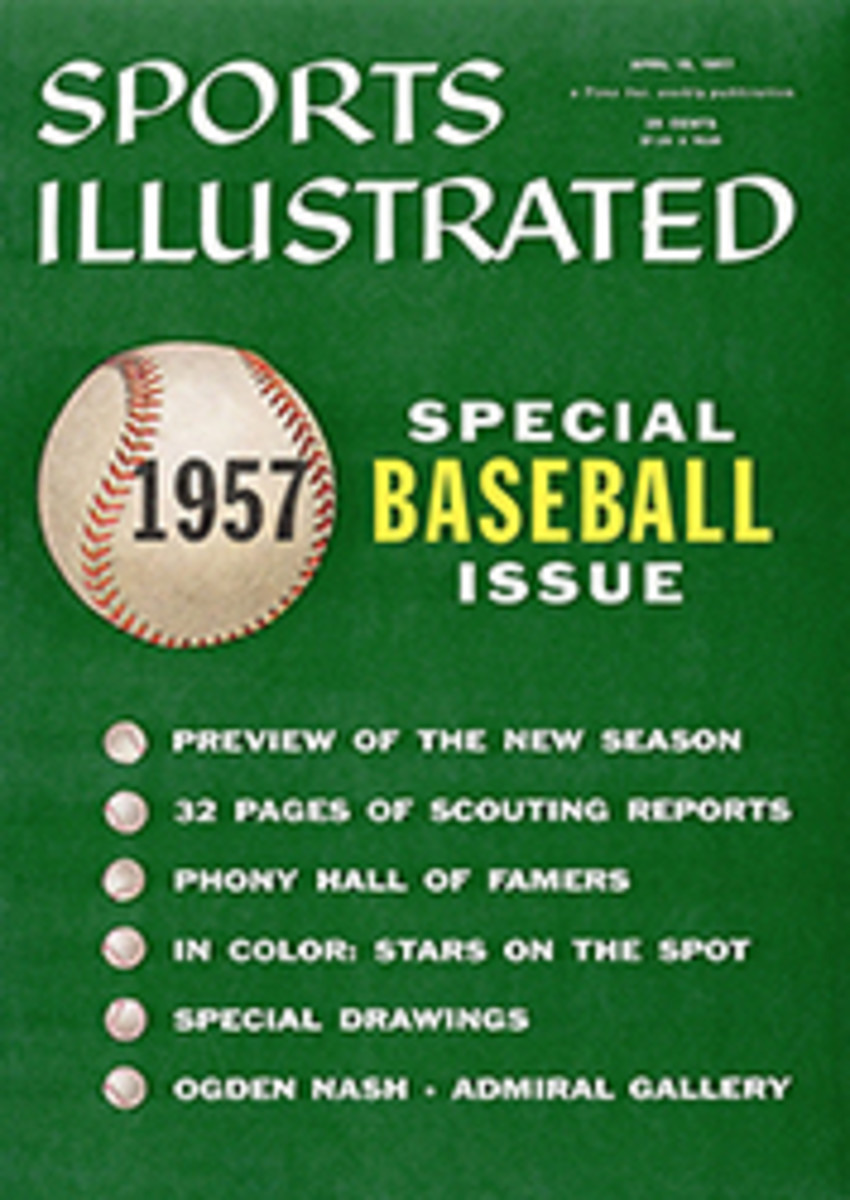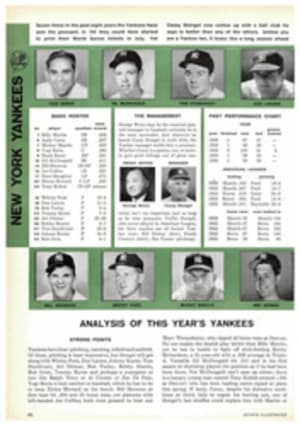
TWO SHOTS THAT WON THE MASTERS
On the final day of the Masters a chunky and relaxed man named Douglas Michael Ford stood in the 15th fairway of the Augusta National course, squinted at the distant green and sluggish creek protecting it and called for the club strong enough to carry all the way, the three-wood. His Negro caddie, who felt he had almost as much at stake, his tip, balked. By the electric word of mouth of tournament golf, news had just reached Doug Ford and his caddie that, behind them on the course, Sam Snead, the tournament leader, was busy bogeying the 10th and 11th holes.
"Use your four-iron," his caddie pleaded in some panic. "Gonna cost me $100 if you go in the water."
"I'm no good at playing safe," Doug Ford snapped. And with that, after the typically brief address he allows himself, Ford swung his spoon back in his oddly flat arc and sent the ball screaming toward the pond. It sailed barely over and kicked to the edge of the green; with two putts he was down for a birdie 4.
That was the way Ford played Augusta, and that—as it turned out—was how the 1957 Masters was won. The day before, while the big crowd was following Snead, Ford tried the same shot and landed in the muck at the edge of the water. He stripped off his shoes, rolled up his pants to the knees, waded in and blasted on his way in a spray of Georgia creek water.
But he was saving his most memorable shot for the last day and the 18th hole. Coming up to the 18th he needed a par 4 to finish with a dazzling 67. But his approach shot, a mis-hit seven-iron, landed in a sand trap short of the green and half buried itself. So Ford scrambled into the trap on the double, without drawing a deep breath flailed at it—and watched it plop right into the cup for a 66. It was the best final-round score in the 21-year history of the Masters. It gave Ford 283 for the tournament and what proved to be a three-stroke margin over Sammy Snead. With some justification he tossed his sand wedge two dozen feet in the air.
Ford is no stylist of golf. He gallops up to his shots, takes a quick look and fires. He goes around the course in Mach One. But he is probably the best man on the circuit at getting down in two putts. At Augusta he played the greens like the pool shark he used to be, and was never far off the tournament pack with tidy daily performances of 72-73-72 and ultimately, of course, the 66. Up to now, at 34, Ford's best triumph was his 1955 PGA victory at Meadowbrook. Hereafter the Mahopac, N.Y. pro can be known as the man who saved the 1957 Masters from what otherwise would have been galling inconclusiveness.
At the end of the third round, after he had posted a bogey-littered 74, Sam Snead confronted the scoreboard in some surprise. "You mean to tell me I shot a 74 and am still leading this man's tournament?" He whistled. "Man, there must be some pea-picking poor golfers in that field out there!"
As a matter of fact, at that moment, there were. Incredibly gone from the tournament were Ben Hogan, Cary Middlecoff, Mike Souchak and a dozen other stars of tournament competition—while still in contention were such venerable figures as Henry Cotton, 50, Henry Picard, 49, and Byron Nelson, 45. The final round of the Masters this year also included 1) a nightclub crooner who plays only to get out in the sun, 2) a dentist from Cucamonga, Calif. and 3) a number of part-time businessmen golfers who haven't fired a golf shot in hope or anger in 20 years.
What had happened was that the tournament committee changed the rules this year to provide for only 40 players in the last two days—the first cut of any kind in Masters history, and drastically, disastrously too far down. The idea was not to cut out the Hogans and the Souchaks but the museum pieces—who proved, on the contrary, to be hardier than some of the youngsters. "We are just as anxious as ever to have the older champions 'come to the party,' although some of them may no longer be serious contenders," tactfully explained Tournament Chairman Cliff Roberts in announcing the innovation last February. "We know that many players...feel obligated to play out the full 72 holes even though they may not be scoring well. The new regulation automatically takes care of this particular problem." It surely did. But it created a locker-room eruption that rocked not only the tournament but all golf.
Cary Middlecoff, for instance, walked seething off the green after he had holed his 152nd shot Friday, stalked into the bar and demanded a triple Scotch which disappeared faster than Doug Ford's last trap shot. This was followed by the disappearance of Middlecoff himself, who did not even slow down on his way out of town to attend the traditional dinner thrown for former champions by last year's champion, a dinner livelier than ever this year judging by the sounds of angry voices drifting out of the club room and through the magnolia leaves.
The point was that many a man has been far back on the second day, only to come on to victory. Burke was eight strokes behind on the last day a year ago and still won.
Despite Doug Ford's wonderful 66, one question which will hum through the gin-and-tonic fumes in the locker rooms all summer is: could Hogan have made up 11 strokes in 36 holes? And, thanks to Ford's smart finish those who watched Ben play the first 36 will have to doubt it. From tee to green he was still almost Hogan, squinting down the wide fairways like a hawk surveying a chicken yard. But on the greens, it was the hawk who became the chicken. If it was anybody but Hogan it would have been funny. Ben couldn't have done worse putting with a tire iron. And from a distance, it seemed he was. Hogan finally did not even attack the course any more. In fact he couldn't even defend himself against it. He set a new modern Hogan record with 38 putts in the second round.
The defection seemed, at first, to leave the pickings all to Snead, and Sam swung joyously to the task on Saturday, birdie-ing the first hole with the dash of a cutlass-swinging pirate. But then he turned back into Snead again. He couldn't have been in more trouble on purpose. "Ah been fighting the squirrels all day," he groaned as shot after shot sprayed out of sight into the piney woods. But, the point is, you can spray at Augusta and the squirrels had a chance to see Snead's scythelike two-iron come crashing down through the acorns and pine needles—as the big white nut went rocketing toward the green, curling around trees and almost spitting sparks as it came to a dead stop with a little entrechat on the green. Snead still missed half his two-foot putts, but he had only seven three-putt greens for the first three rounds, which is awful, but for Snead pretty good.
Snead took his loss philosophically although he was a little pained at the way it happened. "I didn't yip hardly any putts today," he complained. "I was nice and relaxed, and thought the whole cake was mine. But here's a man who takes all those one-putts and some no-putts [Ford had chipped in on No. 12, too]. Can't win over that." Grinned Ford, who tends to play a hooking game: "The good Lord cooperated on this course today and made it perfect for my hard ball."
Ford's caddie, George Franklin, struck the only unregenerate note. He still thought his man had played too risky a game. "It worked this year," he observed sourly, still perspiring at the money that almost went in the water on No. 15. "But it ain't gonna work next, I'm telling ya. Man 4 under par shoulda played it safe."
TWO PHOTOS
JOHN G. ZIMMERMAN
FORD SENDS HIS WINNING BUNKER SHOT TO THE CUP IN STORM OF SAND. DAY BEFORE (RIGHT) HE WADED IN FOR AMPHIBIOUS BLAST ON 15TH
PHOTO
JOHN G. ZIMMERMAN
GOLFER CROSBY WATCHED FROM SIDELINES
PHOTO
BOB JONES, MASTER OF MASTERS, FOLLOWED THE TOURNAMENT PLAY FROM OFFICIAL CART
PHOTO
PALMER, DESPITE FINE 69, WOUND UP SEVENTH
PHOTO
DEMARET GOT TWO 70S, CAME IN THIRD
PHOTO
CARY MIDDLECOFF DROPPED OUT AFTER SECOND-ROUND PRUNINGS
PHOTO
HOGAN, SHOWN WITH WIFE VALERIE, WAS ALSO PRUNING VICTIM
PHOTO
SAM SNEAD, HERE SWINGING DOWN THE 10TH FAIRWAY ON FIRST DAY, LED TOURNAMENT WELL INTO THE FINAL ROUND, FINISHED SECOND

